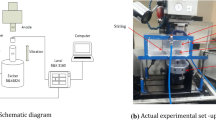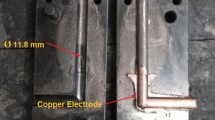Abstract
The frequency-aided electrical erosion machining process can enhance the process mechanism and efficacy. It is time consuming to choose the optimal vibration-oriented parameters in the electrical discharge machining (EDM) process. In the present study, the technique for order of preference by similarity to ideal solution (TOPSIS) based multi-attribute optimization was proposed in the process on machining high silicon-carbon tool steel under low vibrational frequency of the workpiece material. The surface roughness, material removal rate, micro-hardness, and white layer thickness were chosen as quality measures. The experimental investigation was performed by comparing TOPSIS engineering optimization with Deng’s approach, preference selection index, grey relational analysis, the Visekriterijumsko–Kompromisino–Rangiranje (VKR) approach, simple additive weighting, and complex proportional assessmentto analyse the accuracy of the TOPSIS approach. From the experimental analysis, it was inferred that the low-frequency vibration-associated workpiece can considerably improve the quality factors in EDM. The Taguchi–TOPSIS approach can provide a better computational approach to resolve the multi-objective optimal problem.
Similar content being viewed by others
References
Maity KP, Choubey MA (2019) Review on vibration-assisted EDM, micro-EDM and WEDM. Surf Rev Lett 26:1830008. https://doi.org/10.1142/S0218625X18300083
Muthuramalingam T, Mohan B, Jothilingam A (2014) Effect of tool electrode re-solidification on surface hardness in electrical discharge machining. Mater Manuf Process 29:1374–1380. https://doi.org/10.1080/10426914.2014.930956
Muthuramalingam T, Mohan B, Rajadurai A, Prakash MDAA (2013) Experimental investigation of iso energy pulse generator on performance measures in EDM. Mater Manuf Process 28:1137–1142. https://doi.org/10.1080/10426914.2013.811749
Zhu G, Zhang M, Zhang Q, Song Z, Wang K (2018) Machining behaviors of vibration-assisted electrical arc machining of W9Mo3Cr4V.Int. J Adv Manuf Technol 96:1073–1080. https://doi.org/10.1007/s00170-018-1622-9
Yu L, Chang H, Zhang W, Ma F, Sha Z, Zhang S (2017) Study on gap flow field simulation in small hole machining of ultrasonic assisted EDM. IOP Conf Ser Mater Sci Eng 280:1–7. https://doi.org/10.1088/1757-899X/280/1/012009
Muthuramalingam T (2019) Effect of diluted dielectric medium on spark energy in green EDM process using TGRA approach. J Clean Prod 238:117894. https://doi.org/10.1016/j.jclepro.2019.117894
Phan HN, Tien LB, Khan AM, Duc QT, Van DP (2020) Application of TGRA-based optimisation for machinability of high-chromium tool steel in the EDM process. Arab J Sci Eng 45:5555–5562. https://doi.org/10.1007/s13369-020-04456-z
Muthuramalingam T, Mohan B (2013) Enhancing the surface quality by iso pulse generator in EDM process. Adv Mater Res 622–623(1):380–384. https://doi.org/10.4028/www.scientific.net/AMR.622-623.380
Geethapriyan T, Kalaichelvan K, Muthuramalingam T (2016) Multi performance optimization of electrochemical micro-machining process surface related parameters on machining inconel 718 using Taguchi-grey relational analysis. La Metallurgia Italiana 108(4):13–19
Kumar PN, Rajadurai A, Muthuramalingam T (2018) Multi response optimization on mechanical properties of silica fly ash filled polyester composites using taguchi-grey relational analysis. Silicon 10(4):1723–1729. https://doi.org/10.1007/s12633-017-9660-8
Qudeiri JEA, Mourad AHI, Ziout A, Abidi MH, Elkaseer A (2018) Electric discharge machining of titanium and its alloys: review. Int J Adv Manuf Technol 96:1319–1339. https://doi.org/10.1007/s00170-018-1574-0
Unune DR, Mali HS (2017) Experimental investigation on low-frequency vibration assisted micro-WEDM of Inconel 718. Eng Sci Technol Int J 20:222–231. https://doi.org/10.1016/j.jestch.2016.06.010
Unune DR, Mali HS (2018) Experimental investigation on low-frequency vibration-assisted µ-ED milling of Inconel 718. Mater Manuf Process 33:964–976. https://doi.org/10.1080/10426914.2017.1388516
Mishra V, Pandey PM (2018) Experimental investigations into electric discharge grinding and ultrasonic vibration-assisted electric discharge grinding of Inconel 601. Mater Manuf Process 33:1–13. https://doi.org/10.1080/10426914.2018.1453143
Bajpai V, Mahambare P, Singh RK (2016) Effect of thermal and material anisotropy of pyrolytic carbon in vibration-assisted micro-EDM process. Mater Manuf Process 31:1879–1888. https://doi.org/10.1080/10426914.2015.1127937
Muthuramalingam T, Ramamurthy A, Sridharan K, Ashwin S (2018) Analysis of surface performance measures on WEDM processed titanium alloy with coated electrodes. Mater Res Express 5:126503. https://doi.org/10.1088/2053-1591/aade70
Walia R, Kumar S, Grover S (2017) Optimisation strategies in ultrasonic vibration assisted electrical discharge machining: a review. Int J Precis Technol 7:51–83. https://doi.org/10.1504/IJPTECH.2017.10005512
Majumder H, Maity K (2017) Optimization of machining condition in WEDM for titanium grade 6 using MOORA coupled with PCA-A multivariate hybrid approach. Int J Adv Manuf Syst 16:81–99. https://doi.org/10.1142/S0219686717500068
Pantula PD, Miriyala SS, Mitra KKERNEL (2017) Enabler to build smart surrogates for online optimization and knowledge discovery. Mater Manuf Process 32:1162–1171. https://doi.org/10.1080/10426914.2016.1269918
Huu PN, Ngoc VN, Quoc TN. Optimizing process parameters in edm using low frequency vibration for material removal rate and surface roughness, J King Saud Univy-Eng Sci. https://doi.org/10.1016/j.jksues.2020.05.002
Soumitri S, Subramanian V, Mitra K (2018) TRANSFORM-ANN for online optimization of complex industrial processes: Casting process as case study. Eur J Oper Res 264:294–309. https://doi.org/10.1016/j.ejor.2017.05.026
Soumitri S, Mittal P, Majumdar S, Mitra K (2016) Comparative study of surrogate approaches while optimizing computationally expensive reaction networks. Chem Eng Sci 140:44–61. https://doi.org/10.1016/j.ces.2015.09.030
Raj SON, Prabhu S (2017) Analysis of multi objective optimisation using TOPSIS method in EDM process with CNT infused copper electrode. Int J Mach Mach Mater 19:76–94. https://doi.org/10.1504/IJMMM.2017.081190
Geethapriyan T, Muthuramalingam T (2019) Kalaichelvan KInfluence of process parameters on machinability of inconel 718 by electrochemical micromachining process using TOPSIS technique. Arab J Sci Eng 44:7945–7955. https://doi.org/10.1007/s13369-019-03978-5
Sakthivel G, Saravanakumar D, Muthuramalingam T (2018) Application of failure modeand defects analysis in manufacturing industry-an integrated approach with FAHP-FUZZY TOPSIS and FAHP-FUZZY VIKOR.Int.. J Product Qual Manag 24:398–423. https://doi.org/10.1504/IJPQM.2018.092984
Huo J, Liu S, Wang Y, Muthuramalingam T, Pi VN (2018) Influence of process factors on surface measures on electrical discharge machined stainless steel using TOPSIS. Mater Res Express 6:086507. https://doi.org/10.1088/2053-1591/ab1ae0
Van DN, Van BP, Huu PN (2019) Application of Deng’s similarity based–AHP approach in parametric optimization of EDM process for SDK11 die steel. Trans Can Soc Mech Eng. https://doi.org/10.1139/tcsme-2019-0132
Unune DR, Nirala CK, Mali HS (2019) Accuracy and quality of micro-holes in vibration assisted micro-electro-discharge drilling of Inconel 718. Measurement 135:424–437. https://doi.org/10.1016/j.measurement.2018.11.067
Lee SH, Li X (2003) Study of the surface integrity of the machined workpiece in the EDM of tungsten carbide. J Mater Process Technol 139:315–321. https://doi.org/10.1016/S0924-0136(03)00547-8
Muthuramalingam T (2019) Measuring the in ence uence of discharge energy on white layer thickness in electrical discharge machining process. Measurement 131:694–700. https://doi.org/10.1016/j.measurement.2018.09.038.
Author information
Authors and Affiliations
Corresponding author
Rights and permissions
About this article
Cite this article
Huu Phan, N., Muthuramalingam, T. Multi-criteria Decision-making of Vibration-aided Machining for High Silicon-carbon Tool Steelwith Taguchi–topsis Approach. Silicon 13, 2771–2783 (2021). https://doi.org/10.1007/s12633-020-00632-w
Received:
Revised:
Accepted:
Published:
Issue Date:
DOI: https://doi.org/10.1007/s12633-020-00632-w




